Flashes of Colour: Legendary Wines and Gemstones
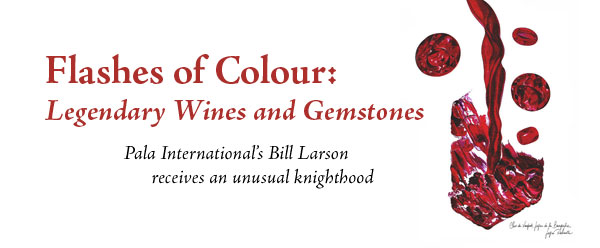 |
In late June 2007, Pala International supplied over $1 million worth of gemstones and mineral specimens to a remarkable exhibition of fine wines and gemstones in Dijon, France: “Flashes of Colour: Legendary Wines and Gemstones.”
The show, which runs through December 9, was produced in partnership with the French National Museum of Natural History and the Interprofessional Bureau for Burgundy Wines, as well as the Jules Guyot Institute (a winemaking school) and the UNESCO Chair of Wines and Culture (a cultural and scientific networking body).
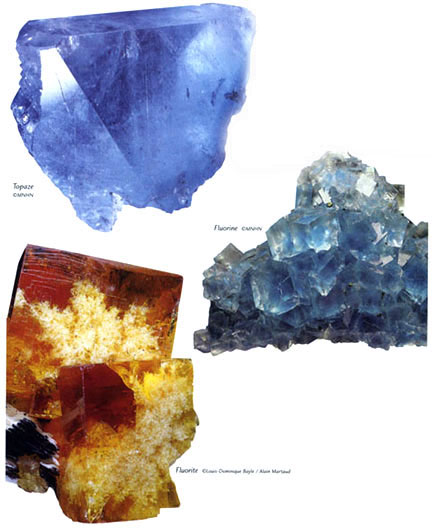 |
| Topaz (top) and fluorine (middle) specimens, from the French National Museum of Natural History. Fluorite specimen from the collection of Alain Martaud. (Photos from the exhibition catalog) |
Bill is Made a Chevalier
On September 22, Bill returned to France to be inducted into the prestigious wine tasters’ fraternity of the Burgundy region, the Confrérie des Chevaliers du Tastevin (Brotherhood of the Knights of the Tastevin [tasting cup]).
 |
| Château du Clos de Vougeot, the location of the ceremony, as seen through the entrance. The château and its vineyards were the property of a Cistercian abbey until the French Revolution. The vineyard was founded in 1098. (Photo: Visitor’s Guide) |
The Confrérie was founded in 1934, taking as its inspiration the disbanded bacchic brotherhoods of the 17th and 18th centuries. The Confrérie’s establishment allowed focus to be placed on local wines that were of particular quality, but that had languished due to the economic crisis of the late 1920s and ’30s.
The Confrérie’s home, the Château du Clos de Vougeot, is host to numerous seasonal events, known as Chapitres (chapters). It was at such a Chapitre—the 1001st, in fact—that Bill Larson was inducted into the Brotherhood, in September. As explained on its website:
Heads of state, ministers, ambassadors, royalty, Nobel prize-winners or writers, famous military or business leaders, sport champions, singers or actors, all have come or will come one evening or another to the Cistercian cellar to have the moving experience of going through the “Cercles du Vin.” ...
Yet, the “Tastevin” does not just receive “anyone” no matter how successful he or she may be. It appreciates merit as well as talent, it likes to honour courage, personal endeavour, scientific intelligence, the love of France and fulfilment of human values.
The honor of the title Chevalier du Tastevin was awarded to Bill, in the field of letters of science, for his generous contributions to the museums of France in the form of gemstones and mineral specimens for display, and his expertise and involvement with exhibit productions. (The major portion of the gems and minerals in “Flashes of Colour” were from Bill’s collection.)
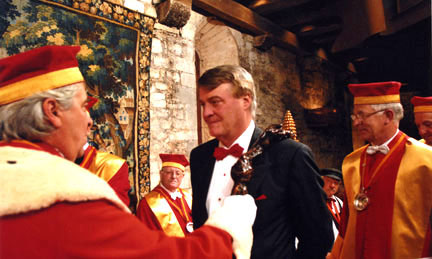 |
| The Chevalier assuming the position. Bill Larson is about to receive the tastevin (tasting cup) of this “Brotherhood of Knights.” (Photo courtesy Confrérie des Chevaliers du Tastevin) |
Gracing the cover of this particular Chapitre’s ceremonial booklet (pictured below) is a painting by Joyce Delimata. This abstract expressionist artist was instrumental in highlighting the theme of color with her organic and erotic paintings. Showing common hues of wines and gems, she seems to span the mediums of color. (To see Delimata at work on this same painting, visit this Japanese weblog—and scroll down.)
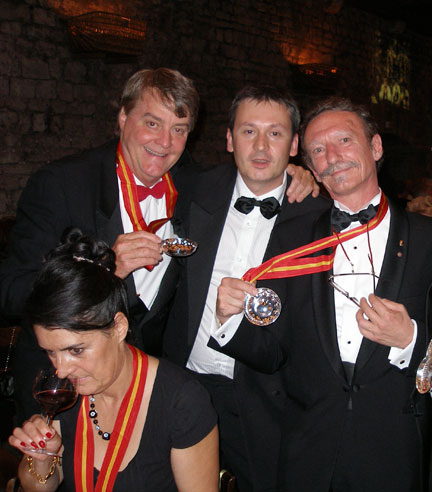 |
| Knighted. Newly inducted chevaliers (knights) of the wine tasters’ fraternity, Bill Larson (left) and Giancarlo Parodi (right), show off their tastevins (tasting cups) to connoisseur of fine wines and minerals (and “Flashes of Colour” contributor) Alain Martaud (center), as fine artist Joyce Delimata, also inducted, checks the nose on a glass of local red. Delighted. Delimata’s image below was featured on the Chapitre’s ceremonial booklet. She also showed her work in conjunction with the “Flashes of Colour” exhibition. |
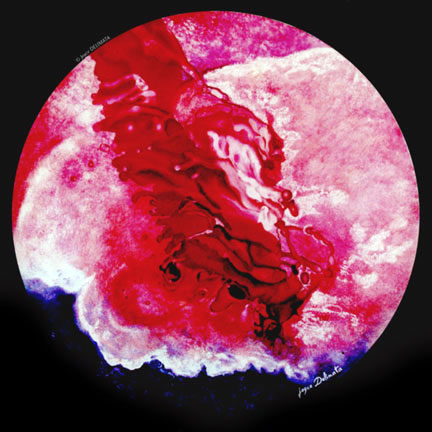 |
From Abbey to Abbey
The timing was right for Bill to attend a symposium held the next day at yet another abbey, L’Abbaye de Fontenay, also in Burgundy and also Cistercian (the order of St. Bernard of Clairvaux). The subject of the symposium was the medieval composer and visionary, Hildegard of Bingen. Bill joined Giancarlo Parodi, curator of the Dijon exhibition (and Lecturer at the National Museum of Natural History, Paris), Parodi’s friend Sophie, and Françios Farges for the scholarly affair. Farges, who is Professor and Chief-Curator of the National Natural History Museum in Paris, would deliver a lecture on Hildegard’s contributions to mineralogy (she authored a lapidary, amongst other works).
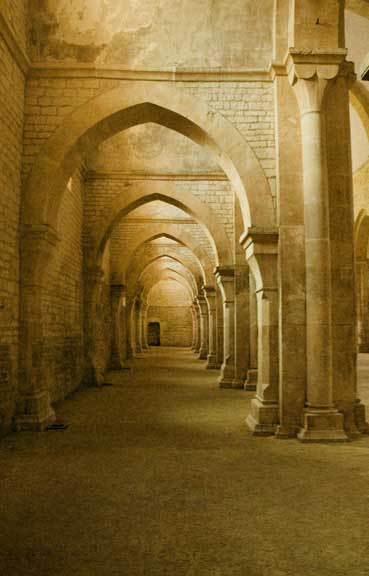 |
| Romanesque meets Gothic. These archways are an architectural time machine, demonstrating a transition from the solid Romanesque style of the early 12th century to a distinctive expression of the Gothic that would thrive for the next four centuries. (Photo: Bill Larson) |
The abbey at Fontenay is a fine example of Romanesque style. Except for one building that was destroyed (the refectory), all the rooms have been preserved. The garden, pictured below, was originally used to grow medicinal herbs. It was recently redesigned by garden architect Peter Holmes.
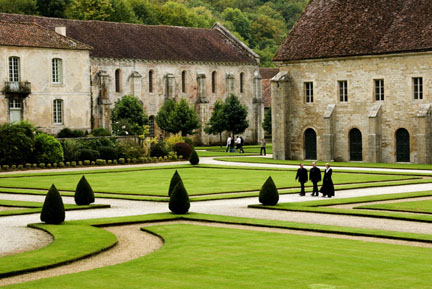 |
| In the footsteps of St. Bernard. Although the medieval saint might not actually have set foot on this location, he founded the abbey whose monks went on to occupy this site in Fontenay, Burgundy (not to be confused with the abbey owned by the Confrérie). In the foreground, Giancarlo Parodi, François Farges, and Giancarlo’s friend Sophie stroll the grounds of what is now a private residence. Its owners were hosting a symposium on Hldegard of Bingen, who, while best known for her music, also wrote on physics, chemistry, mineralogy, and geology. (Photo: Bill Larson) |
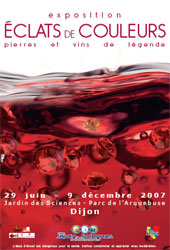 |
Flashes of Colour: Pala Exhibits Eighty Gems and
Minerals in Dijon
The Dijon exhibition continues, in the Sciences Garden at the Parc de l’Arquebuse. The show compares the “true colors of wine... with the innumerable nuances offered by fine and invaluable stones.”
Included are items from the French National Museum of Natural History, private collections, and national museums, as well as wines by the great vintners of Burgundy and beyond. In conjunction with the exhibition are wine tastings, “experiments on light and color,” workshops on sensory perception, conferences, and more.
The French approach to this exhibit has been very novel and eye opening in its way of describing color as it traverses through different mediums. To associate the common colors we see everyday—through the craft of painting, wine, and stained glass—with colors that are naturally born in gems—through complex pairings of elements in unusual conditions within the earth—is a mind-blending idea.
 |
| Medieval village. Catching a “flash of colour,” the fortress town of Semur-en-Auxois was on the road back to Dijon from the abbey in Fontenay. (Photo: Bill Larson) |
Behind this idea is Giancarlo Parodi, friend and associate of Pala International. Bill’s ability to share Giancarlo’s vision was crucial in assembling the gems and minerals capable of exhibiting the full color palette that would eventually be tied to their common color counterpart in the liquid medium of fine wine. This beautiful relationship of color was indeed realized and became a masterful exhibit. Also playing an instrumental role in the production of the exhibit was François Farges, curator of the National Natural History Museum.
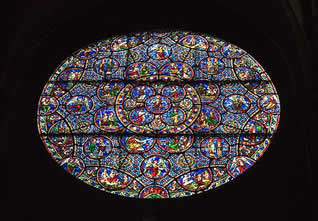 |
| Like a pixilated opal, this stained glass window is from the nave in the Church of Notre-Dame, across the street from Bill’s bus stop in Dijon. (Photo: Bill Larson) |
Bill’s continued interest in and enthusiasm toward working with many of the world’s great museums has brought wonderful and colorful exhibits to the forefront of display. With a passion for everything gem related he has utilized museums as conduits to bring the science and intrigue of gems and minerals to the public. This symbiotic relationship—with Bill as supplier and the institution as showcase—has allowed for many public mineral spectacles and, consequently, instilled the sense of a communal necessity to indulge in mother nature’s creations.
Intentions are now focused on bringing this “Flashes of Colour” concept across the pond to the U.S., allowing the rest of us to delight in the sight and taste of color.
From the Show
Below is a sampling of some of the gems, minerals, and carvings that were featured in the exhibit and pictured in the collection catalog.
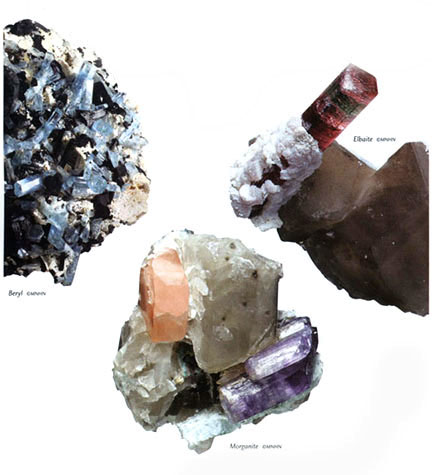 |
| Beryl (left)elbaite (right) and morganite specimens, from the French National Museum of Natural History. (Photos from the exhibition catalog) |
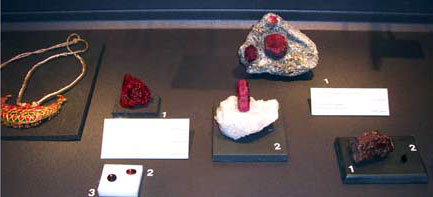 |
| These rough and cut rubies and spinels help set off some of the fine red wines. At left is an antique necklace encrusted with rubies. (Photo: Bill Larson) |
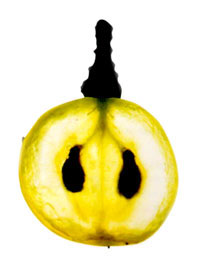 |
| Blonde beauty. Ugni blanc is used as the base of several dry white wines. (Photo © Françoise Dordor & Clothilde Verriès, INRA-Cité du Vin, from the exhibition catalog) |
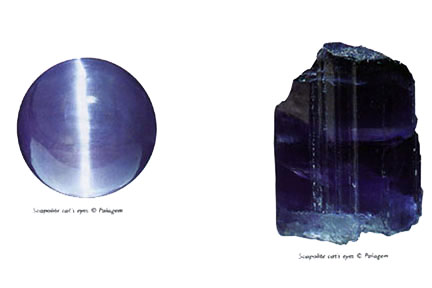 |
| Scapolite, rough and cut, from the Pala International collection. (Photos from the exhibition catalog) |
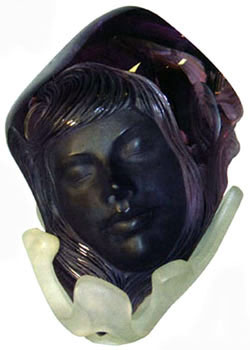 |
| Carved nymph in amethyst, from the Pala International collection. (Photo from the exhibition catalog) |
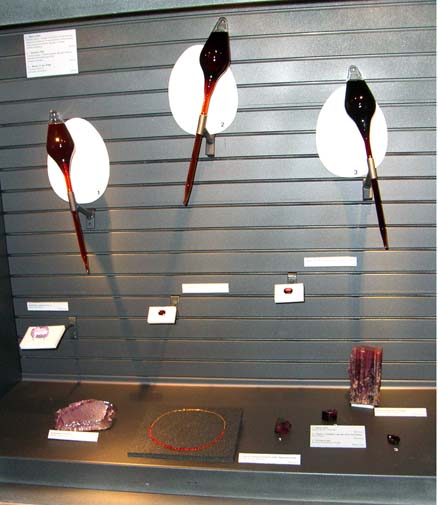 |
| Color in different forms. This exhibit compares the color in wine and gemstones. The custom-made flasks (top) allow the color of these classic reds from Burgundy to be appreciated without oxidation. The large tourmaline at lower right is from Pala, California, and was mined shortly before it was gifted to National Museum of Natural History in 1904. (Photo: Bill Larson) |
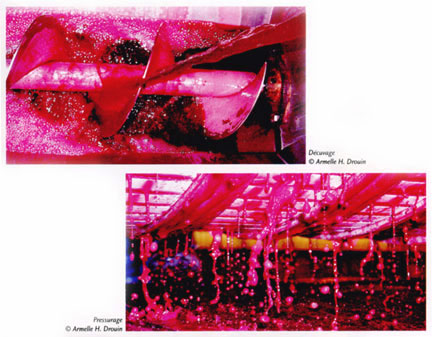 |
| Décuvage and pressurage. Above, the juice is “racked,” or separated from its sediment. Below, the fruit is pressed. (Photos © Armelle H. Drouin, from the exhibition catalog) |